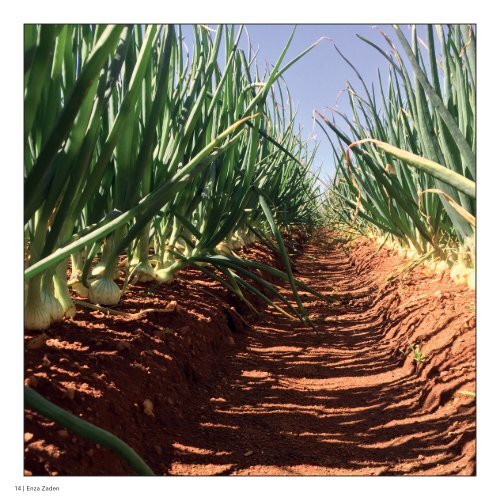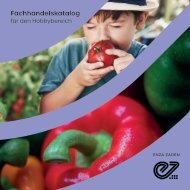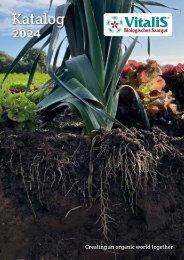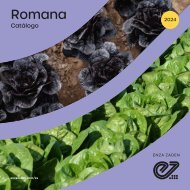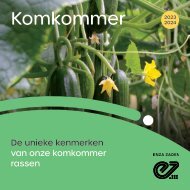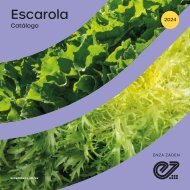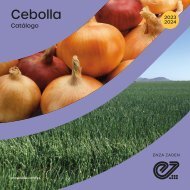Onion South Africa 2018
Create successful ePaper yourself
Turn your PDF publications into a flip-book with our unique Google optimized e-Paper software.
Resistances<br />
Resistances in varieties of our crops will be coded<br />
(please, see our coding list on www.enzazaden.<br />
com for explanation), unless indicated otherwise.<br />
Varieties claiming the same level of resistance<br />
against a specific pest or pathogen may exhibit<br />
a different resistance response due to a different<br />
genetic makeup of a variety.It is to be noted that if<br />
a resistance is claimed in a plant variety it is limited<br />
to the specified biotypes, pathotypes, races or<br />
strains of the pest or pathogen.<br />
If no biotypes, pathotypes, races or strains are<br />
specified in the resistance claim for the variety,<br />
it is because no generally accepted classification<br />
of the cited pest by biotype, pathotype, race or<br />
strain exists. In this case resistance is only claimed<br />
against certain not further specified isolates of<br />
that pathogen. New biotypes, pathotypes, races<br />
or strains that may emerge are not covered by the<br />
original resistance claim.<br />
Immunity: not subject to attack or infection by a<br />
specified pest or pathogen<br />
Resistance: the ability of a plant variety to restrict<br />
the growth and development of a specified pest<br />
or pathogen and/or the damage they cause when<br />
compared to susceptible plant varieties under<br />
similar environmental conditions and pest or<br />
pathogen pressure. Resistant varieties may exhibit<br />
some disease symptoms or damage under heavy<br />
pest or pathogen pressure.<br />
Two levels of resistance are defined:<br />
• High resistance (HR): plant varieties that<br />
highly restrict the growth and development<br />
of the specified pest or pathogen under<br />
normal pest or pathogen pressure when<br />
compared to susceptible varieties.<br />
These plant varieties may, however, exhibit<br />
some symptoms or damage under heavy pest<br />
or pathogen pressure.<br />
• Intermediate resistance (IR): plant varieties<br />
that restrict the growth and development<br />
of the specified pest or pathogen, but may<br />
exhibit a greater range of symptoms or<br />
damage compared to highly resistant varieties.<br />
Intermediate resistant plant varieties will still<br />
show less severe symptoms or damage than<br />
susceptible plant varieties when grown under<br />
similar environmental conditions and/or pest<br />
or pathogen pressure.<br />
Susceptibility: the inability of a plant variety to<br />
restrict the growth and development of a specified<br />
pest or pathogen.<br />
Tolerance: the ability of a plant variety to endure<br />
abiotic stress without serious consequences<br />
for growth, appearance and yield. Vegetable<br />
companies will continue to use tolerance for<br />
abiotic stress.<br />
Full explanation available on www.enzazaden.com<br />
Disclaimer<br />
Descriptions, recommendations and illustrations in brochures and leaflets shall correspond as closely as possible to tests and practical experience and are subject<br />
to typographical and/or printing errors. This information shall be provided to assist professional growers and users, whereby variable local conditions must be<br />
taken into account. Under no circumstances shall Enza Zaden accept liability based on such information for deviating results in the cultivated product. Current<br />
information concerning the resistances is available on www.enzazaden.co.za<br />
14 | Enza Zaden<br />
Enza Zaden | 15


